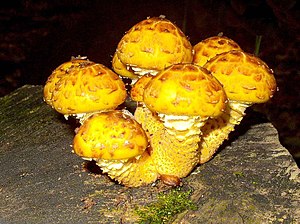Goldfur Schüppling
| Goldfur Schüppling | ||||||||||||
|---|---|---|---|---|---|---|---|---|---|---|---|---|

Goldfur Schüppling ( Pholiota aurivella ) |
||||||||||||
| Systematics | ||||||||||||
|
||||||||||||
| Scientific name | ||||||||||||
| Pholiota aurivella | ||||||||||||
| ( Batsch : Fr. ) P. Kummer |
The Goldfell-Schüppling ( Pholiota aurivella , syn. Ph. Cerifera ) is a type of mushroom from the family of the Traulle relatives . Sometimes the name is wrongly used for the high throne Schüppling ( Ph. Limonella ).
The epithet of the scientific species name consists of the two word elements "aur-" from Latin "aurum" (gold) and Latin "vellus" (fleece, fur) and refers to the rusty yellow, scaly surface of the hat.
features
Macroscopic features
Probably the most noticeable feature of the Goldfell Schüpping is its golden to dark or rusty yellow hat. Its surface is covered with scales that are darker than the hat. In the initial stage, the spherical hat is closed and partly - also at the edge - covered with remains of the velum , later it spreads and takes on a curved shape. As a result, the thick-fleshed hat can be 5–12 (–16) cm wide. The hat is greasy or a bit slimy, especially in damp weather. The slats are initially tinted yellow. They later turn olive-rust brown. The cutting edge is often ciliated. The spore powder is also rusty brown. The curved stem is on average 5–8 cm long with a thickness of about one to two centimeters. It is only slightly lighter in color than the hat. The surface is fibrous-flaky to slightly fibrous-flaky and not slimy. The white-yellow flesh is firm and tough. However, the flesh close to the hyphae in the handle ( i.e. at the base of the handle) has a rust-brown color. The smell is described as radish-like, the taste is mild.
Microscopic features
The spores are elliptical in shape and have a fine germ pore . They measure 7-10 x 4.5-6 micrometers. The Cheilo cystiden are slender, bottle-shaped. The chrysocystids are slightly longer and pointed.
Species delimitation
There are a few more Schüpplinge with yellow hats and darker scales. The slimy Schüppling ( Ph. Adiposa ) has a slimy stem; the spores measure 5.5–6.5 × 3–4 µm. The fatty Schüppling ( Ph. Lucifera ) grows on wood buried in the ground. Likewise, the brush-shoveling ( Ph. Jahnii ) can often be found apparently on the ground. He has protruding scales. The smaller high-enthroned Schüppling ( Ph. Limonella ) is also dull yellow to almost whitish or brown-yellow in color. Its spores measure 6.5–8 × 4–5 µm. The three last-named species are usually smaller than the gold fur schüppling, the hats having a maximum diameter of 8 cm.
Ecology and phenology
Goldfell-Schüppling can be found in beech, fir-beech and fir forests. It lives parasitically or as a saprobiont on living and freshly felled trunks. Deciduous trees in particular are populated , primarily red beeches , and more rarely coniferous wood .
The fruiting bodies appear in autumn, especially from September to November, rarely also during the winter months and in spring. They grow in tufts and can appear from the region of the base of the tree to the top of the tree. The fruiting bodies prefer wounds and crevices in the bark to protrude.
distribution
The gold skin shingling is common in the Holarctic . It can be found in Europe, North Asia , North Africa and North America , especially in Canada . In Europe, the area extends from Great Britain and France in the west to Estonia and Belarus in the east as well as north to Fennoscandinavia and in the south to Italy, Greece and Romania. In Germany, the fungus can be found scattered from the plains to the lower mountains. In general, the species is more widespread in the lowlands than in the mountains.
Systematics
A var. Cerifera has been described, which is characterized by a drier hat, clubbed cheilo cystidia and a relatively pronounced attachment to willow ( Salix ). However, these characteristics are not constant.
meaning
The Goldfell-Schüppling is edible, but not very tasty. Young fruit bodies can be used in the mixed mushroom dish.
swell
literature
- Josef Breitenbach, Fred Kränzlin (Ed.): Mushrooms of Switzerland. Contribution to knowledge of the fungal flora in Switzerland. Volume 4: Agarics. Part 2: Entolomataceae, Pluteaceae, Amanitaceae, Agaricaceae, Coprinaceae, Bolbitiaceae, Strophariaceae. Mykologia, Luzern 1995, ISBN 3-85604-040-4 .
Individual evidence
- ↑ Erhard Ludwig: Descriptions. The smaller genera of macromycetes with a lamellar hymenophore from the orders Agaricales, Boletales and Polyporales . In: Mushroom Compendium . tape 1 . IHW, Eching 2001, ISBN 978-3-930167-43-2 (758 pages, German with English summaries, 17 × 24 cm, contains 20 new taxa and 13 new combinations).
- ↑ Helmut Genaust: Etymological dictionary of botanical plant names. 3rd, completely revised and expanded edition. Nikol, Hamburg 2005, ISBN 3-937872-16-7 (reprint from 1996).
- ↑ Fritz Clemens Werner: Word elements of Latin-Greek technical terms in the biological sciences . Suhrkamp, 1972, ISBN 978-3-518-36564-9 (Suhrkamp Taschenbuch 64).
- ↑ a b c Ewald Gerhardt: FSVO manual mushrooms . 4th edition. BLV, Munich 2006, ISBN 3-8354-0053-3 , p. 640 pages .
- ^ German Josef Krieglsteiner (Ed.), Andreas Gminder : Die Großpilze Baden-Württemberg . Volume 4: Mushrooms. Blattpilze II. Ulmer, Stuttgart 2003, ISBN 3-8001-3281-8 .
- ↑ Ewald Gerhardt: Mushrooms. Determine accurately with the 3-check . BLV, Munich 2004, ISBN 3-405-16128-2 (238 pages).

